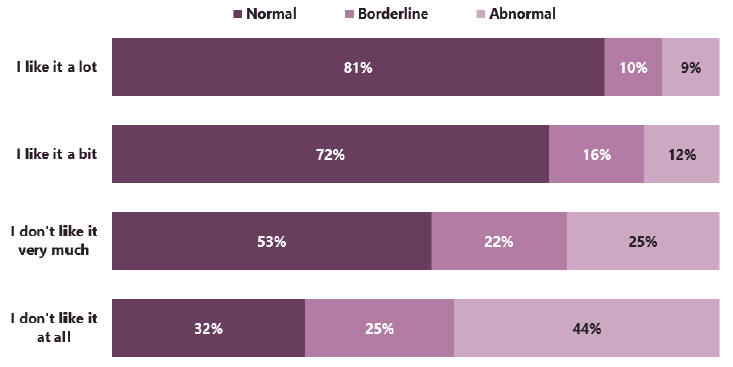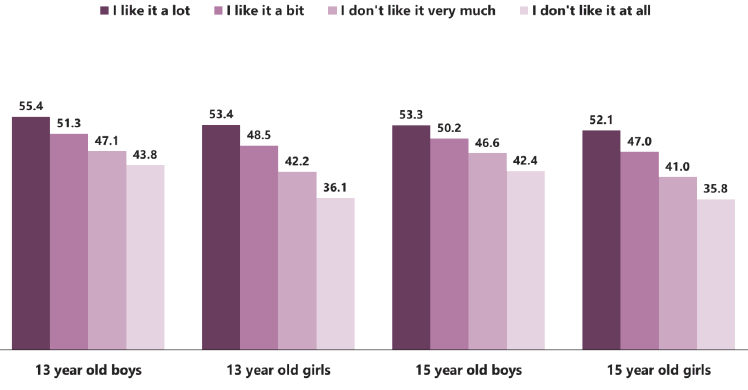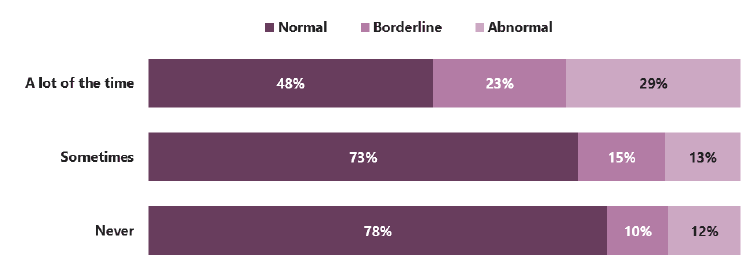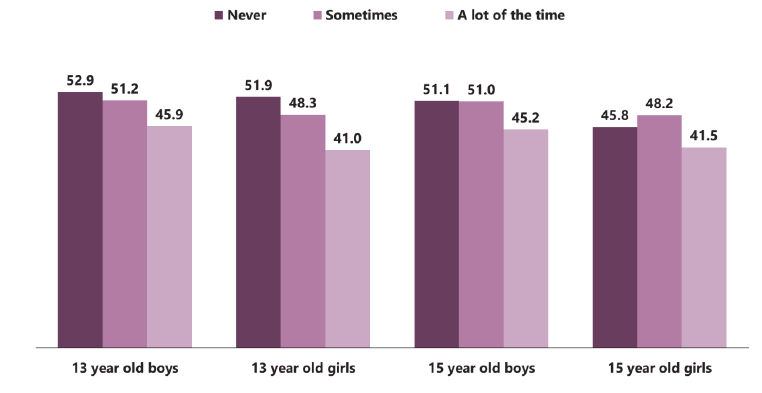Scottish Schools Adolescent Lifestyle and Substance Use Survey (SALSUS): mental wellbeing report 2018
Mental health and wellbeing findings from the 2018 wave of the Scottish Schools Adolescent Lifestyle and Substance Use Survey (SALSUS).
This document is part of a collection
5 Emotional and behavioural problems, mental wellbeing by school variables
The school variables analysed in this chapter are whether pupils like school and whether they feel pressured by their schoolwork. These variables are analysed using the overall SDQ score and the mean WEMWBS score to determine whether each school variable was correlated with emotional and behavioural problems, and mental wellbeing, respectively.
Liking school
Emotional and behavioural problems
Whether a pupil liked school was strongly associated with overall SDQ scores. Those who don't like school at all were more than three times as likely to have a borderline or abnormal SDQ score than those who like school a lot (68%, compared with 19%) (Figure 5.1).

A graph showing overall SDQ scores of pupils based on whether pupils liked school.
The figure indicates that of pupils who said ‘I like it a lot’, 81% scored within the normal SDQ range, 10% within the borderline range, and 9% within abnormal range.
The figure indicates that of pupils who said ‘I like it a bit’, 72% scored within the normal SDQ range, 16% within the borderline range, and 12% within abnormal range.
The figure indicates that of pupils who said ‘I don’t like it very much’, 53% scored within the normal SDQ range, 22% within the borderline range, and 25% within abnormal range.
The figure indicates that of pupils who said ‘I don’t like it at all’, 32% scored within the normal SDQ range, 25% within the borderline range, and 44% within abnormal range.
Base: See Appendix A
Mental wellbeing
Again, there was a very clear pattern in terms of pupils' attitudes to school and their mental wellbeing. Those who did not like school were more likely to have lower mental wellbeing than those that did.
This association was stronger among girls than boys and this was true across both age groups (Figure 5.2).

A graph showing mean WEMWBS scores of 13 year old boys and girls, and 15 year old boys and girls based on whether they liked school.
The figure indicates that 13 year old boys that said ‘I like school a lot’ had a mean score of 55.4, those that said ‘I like it a bit’ had a mean score of 51.3, those that said ‘I don’t like it very much’ had a mean score of 47.1, and those that said ‘I don’t like it at all’ had a mean score of 43.8.
The figure also indicates that 13 year old girls that said ‘I like school a lot’ had a mean score of 53.4, those that said ‘I like it a bit’ had a mean score of 48.5, those that said ‘I don’t like it very much’ had a mean score of 42.2, and those that said ‘I don’t like it at all’ had a mean score of 36.1.
Additionally, 15 year old boys that said ‘I like school a lot’ had a mean score of 53.3, those that said ‘I like it a bit’ had a mean score of 50.2, those that said ‘I don’t like it very much’ had a mean score of 46.6, and those that said ‘I don’t like it at all’ had a mean score of 42.4.
Finally, 15 year old girls that said ‘I like school a lot’ had a mean score of 52.1, those that said ‘I like it a bit’ had a mean score of 47.0, those that said ‘I don’t like it very much’ had a mean score of 41, and those that said ‘I don’t like it at all’ had a mean score of 35.8.
Base: See Appendix A
Pressure from schoolwork
Emotional and behavioural problems
Pupils were asked how often they felt strained or pressured by the schoolwork they had to do. Those that felt pressured a lot of the time were much more likely to have a borderline or abnormal SDQ score than those who sometimes or never felt pressured (52%, compared with 27% and 22%, respectively) (Figure 5.3).

A graph showing overall SDQ scores, based on how often pupils reported feeling pressure from schoolwork.
The figure shows that of pupils who feel pressure from schoolwork ‘a lot of the time’, 48% scored in the normal range, 23% scored in the borderline range, and 29% scored in the abnormal range.
The figure also shows that of pupils who ‘sometimes’ feel pressure from schoolwork, 73% scored in the normal range, 15% scored in the borderline range, and 13% scored in the abnormal range.
Finally, the figure shows that of students who never feel pressure from schoolwork, 78% scored in the normal range, 10% scored in the borderline range, and 12% scored in the abnormal range.
Base: See Appendix A
Mental wellbeing
Among 13 year olds, the association between pressure from schoolwork and mental wellbeing was straightforward: the more pressure they felt, the lower their mental wellbeing score (Figure 5.4). However, the relationship between these two variables was less clear cut among the older age group. Among 15 year old boys there was no difference in levels of mental wellbeing between those who sometimes or never felt pressured, but there was a drop in mental wellbeing scores among those who felt pressured a lot of the time. Similarly, among 15 year old girls, those who felt pressured by schoolwork a lot of the time had the lowest mental wellbeing score. However, those who never felt pressure had lower mental wellbeing scores than those who felt pressure sometimes.

A graph showing mean WEMWBS scores of 13 year old boys and girls, 15 year old boys and girls based on whether they feel pressure from schoolwork.
13 year old boys that they ‘never’ feel pressure from schoolwork had a mean score of 52.9, those that said they ‘sometimes’ feel pressure had a mean score of 51.2, those who said they feel pressure from schoolwork ‘a lot of the time’ had a mean score of 45.9.
13 year old girls that they ‘never’ feel pressure from schoolwork had a mean score of 51.9, those that said they ‘sometimes’ feel pressure had a mean score of 48.3, those who said they feel pressure from schoolwork ‘a lot of the time’ had a mean score of 41.
15 year old boys that they ‘never’ feel pressure from schoolwork had a mean score of 51.1, those that said they ‘sometimes’ feel pressure had a mean score of 51, those who said they feel pressure from schoolwork ‘a lot of the time’ had a mean score of 45.2.
15 year old girls that they ‘never’ feel pressure from schoolwork had a mean score of 45.8, those that said they ‘sometimes’ feel pressure had a mean score of 48.2, those who said they feel pressure from schoolwork ‘a lot of the time’ had a mean score of 41.5.
Base: See Appendix A
Contact
Email: salsus@gov.scot
There is a problem
Thanks for your feedback